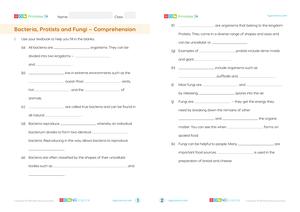Begin the lesson by introducing the fascinating world of fungi, highlighting their unique characteristics and ecological roles. Use engaging visuals to capture students' interest.
Go to the LessonLearning Objectives
- Identify the characteristics and types of fungi, including mushrooms, puffballs, molds, and yeasts.
- Explain the reproduction processes of fungi, such as spore release and budding.
- Describe the ecological role of fungi as decomposers and their importance in nutrient cycling.
- Recognize the beneficial and harmful impacts of fungi on humans, plants, and animals.
- Discuss the uses of fungi in food production and medicine, including yeast in baking and penicillin.
Introduction and Hook
Direct Instruction
Explain the characteristics and types of fungi, including mushrooms, puffballs, molds, and yeasts. Discuss their reproduction processes such as spore release and budding.
Use diagrams and images to illustrate the structure of fungi and their role as decomposers in nutrient cycling.
Guided Exploration
Watch the 'Characteristics of Organisms' video to understand how fungi differ from plants and animals in their survival needs and ecological roles.
Engage students in a discussion about the beneficial and harmful impacts of fungi on humans, plants, and animals.
Hands-On Activity
Independent Practice
Check for Understanding
Review and Reflection
Facilitate a class discussion to reflect on the ecological roles and human uses of fungi. Encourage students to share what they found most interesting about fungi.
Assessment and Extension
Conclude the lesson with the 'The Six Kingdoms of Life' assessment to test comprehension of biological classification and the role of fungi within it.
Try the Quiz





